|
Dazzling
Debuts - 1
These articles discuss the first regular season, bowl, or playoff game of a college or pro player, coach, or team.
October 27, 1951: Olean NY – Louisville @ St. Bonaventure
When Johnny Unitas reported to the University of Louisville as a 145 lb freshman from Pittsburgh, Coach Frank Camp mistook him for the water boy at the first football practice.
- Johnny had large hands and feet as well as long arms and legs that were badly bowed.
- From the beginning, he threw "a sharp pass that came on you quick but, for some reason, was easy to catch," in the words of Jimmy Orr, one of his receivers on the Baltimore Colts in later years.
- Still, Johnny didn't start under C until the fifth game when the Cardinals sported a 1-3 record.
Coach Camp ran a passing O that was sophisticated for that era.
- Other coaches came to Camp for ideas.
- "Camp ran the Chicago Cardinals offense before the Chicago Cardinals," said Blanton Collier, an assistant with the Cleveland Browns who became head coach of Kentucky and then the Browns.
Johnny's first start came against St. Bonaventure in Olean NY.
- Playing in a chilly drizzle, Unitas took an entire half to get into the flow. By that time, the Bonnies led 19-0 behind their QB, Ted Marchibroda, who would coach the Colts from 1975-79 after Unitas retired from the NFL.
- The second half was a different story. Unitas completed 11 straight passes, three for TDs, to give the visitors a 21-19 lead.
Johnny's heroics were spoiled by a highly controversial ending.
- According to the recollections of Marchibroda and others, the Cardinals thought the clock had run out and stormed the field in victory.
- However, officials put more time on the clock. That allowed Walt Czaja to try a FG that missed. Again, Louisville exulted.
- Not so fast, my friend. A penalty was called on the visitors (offside?), giving Czaja another try which he made from the 17 with 0:03 on the clock to give the Bonnies a 22-21 victory.
- According to the AP report on the game, the FG "precipitated a minor sort of riot ... It took officials and special police 15 minutes to clear the field after Czaja's winning boot."
After the game, Coach Camp praised Unitas.
We weren't going anywhere without him, that's for sure. And if he keeps throwing the way he did against St. Bonaventure, he'll do us a lot of good.
Camp's prediction was right on as the Cardinals won their final four games with Unitas at the helm.
Related article: When Johnny U. Came to Tallahassee
Reference: Johnny U: The Life & Times of John Unitas, Tom Callahan (2006)
Top of Page
|
October 3, 1981 – Cougar Stadium,
Provo UT
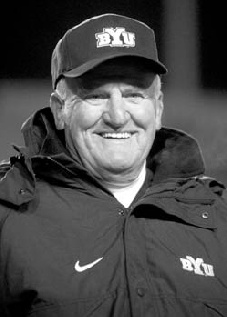
LaVell Edwards |
When Brigham Young faced Utah State on October 3, 1981, the 4-0 Cougars of LeVell
Edwards were without their starting senior QB Jim McMahon due to a knee injury.
- BYU's 16-game winning streak appeared in jeopardy especially after
the visiting Aggies immediately drove 65y
to take a 7-0 lead. This was the first time the Cougars had trailed so far in the season.
- However, the backup signal-caller rallied his mates by throwing for 307y and running for
63 more.
- Trailing 26-20 in the fourth quarter, the sophomore
audibled into a running play that sprang FB Waymon Hamilton for a 42y TD to tie the game.
- The Cougar D then provided the winning score when LB Todd Shell picked off a screen pass and ran 12y with 3:30 left for a 32-26 triumph.
The backup QB was Steve Young, great-great-great grandson of the school's namesake.
- Young played QB well enough the following two
seasons to win the 1983 Sammy Baugh Trophy
and Davey O'Brien Quarterback Award.
- Like McMahon, Young won a Super Bowl and became a member of the College Football Hall of Fame.
|
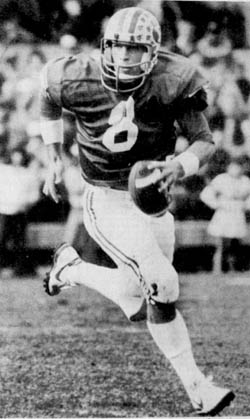
Steve Young
|
September
27, 1952 – Ohio Stadium, Columbus OH
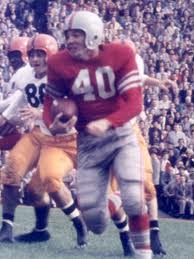
Hopalong Cassady |
A red-haired freshman fireball flashed across the gridiron firmament
today, and the kid's three-touchdown splurge was the margin
by which Ohio State defeated Indiana's Hoosiers,
33-13, in the season's opening Western Conference game.
That was the lead sentence of the AP article on September 28, 1952.
The "red-haired fireball" was Howard "Hopalong"
Cassady, a 168-pound RB/DB from Columbus. He was eligible
as a freshman because he enrolled at OSU the previous January. Second-year coach Woody Hayes installed the split-T formation partly to take advantage of Cassady's skills.
The "outweighed and undermanned Hoosiers"
battled the Buckeyes to a 13-13 tie through three periods. The home team's second
TD had been a 37-yard pass to Cassady from
QB Fred Bruney. Early in the fourth quarter, Cassady ran six yards over LT to culminate
a 49-yard drive that put OSU ahead to stay. Late in the game, Hopalong scored
the Bucks' third
TD of the quarter on a 3-yard run to make the final score 33-13.
Cassady went on to score 37 TDs in 36 games, rushing for 2,466 yards.
Often playing all 60 minutes, he never had a pass completed
on him in any Big Ten game during his four years. His college
career culminated in the Heisman Trophy in 1955.
Read Cassady's
recounting of his first game. Notice how his recollection
has changed the facts over the decades. View brief video on Cassady with game footage.
|
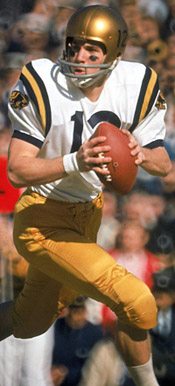
Roger Staubach |
October
13, 1962 – Navy Memorial Stadium, Annapolis MD
Navy was grounded in a scoreless game with Cornell in the third quarter.
- Coach Wayne Hardin decided to take a chance on a sophomore QB who hadn't played much and
ranked far down on the depth chart.
- The hunch paid off as the new QB passed for one TD and ran for two more in only 23 minutes
of play in a 41-0 rout.
- The neophyte went on to lead the NCAA in completion pct. (67.3) that season. The Midshipmen upset
archrival Army 34-14 in the finale.
If you haven't guessed, the QB was Roger
Staubach, the greatest player in Naval Academy history.
- After leading the Middies to an 8-2 record and a Cotton Bowl berth against Texas in his junior year, Roger the Dodger won the
Heisman Trophy.
- An injury unfortunately curtailed his senior year.
- He then served his term in the Navy before starting a Hall of Fame career with the Dallas Cowboys.
|
September 27, 1992 – Lambeau Field, Green Bay WI
Brett Favre from Southern Mississippi was drafted in the second round by the Falcons in 1991 despite the fact that head coach Jerry Glanville insisted he didn't want him. After one undistinguished season
with Atlanta, Favre was traded to Green Bay for a first round pick.
First-year head coach Mike Holmgren didn't start Favre until the fourth game of
the 1992 season against the visiting Pittsburgh Steelers, who were 3-0 under their rookie coach Bill Cowher.
- Two weeks earlier, Favre had entered the game at Tampa
Bay for the second half trailing 17-0.
- His first pass was deflected, and he caught it himself for -7y. He accomplished little in the 31-3 defeat.
- Then the next week, when starter Don Majkowski injured his ankle against the Bengals, Brett played the rest of the way but fumbled
four times, causing the home crowd to chant for third-string QB Ty Detmer.
- Fortunately, Holmgren didn't listen, and Favre rewarded him with
a 92y drive in the last 1:08 culminating in the game-winning TD pass to Kitrick Taylor with 13 ticks left.
Brett played the whole way in his first start, a 17-3 victory over the Steelers.
- He threw two TDs, one to Sterling Sharpe for 76 yards and the other 9 yards to Robert Brooks. His passer rating for his first start was 144.6.
- Little did anyone know at the time that he would never miss another start
for Green Bay until his first retirement (March 2008).
|
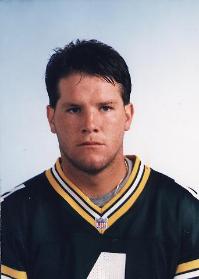
Brett Favre |
September
22 , 1962 – Legion Field, Birmingham AL
Bear Bryant began his fifth season at Alabama
by starting a brash sophomore QB named Joe Willie Namath from Beaver Falls PA. (Freshmen weren't eligible for varsity play in those days.)
- Bear called him "the best player I've ever seen."
- The opening opponent was Wally Butts' Georgia
Bulldogs.
- Namath completed 10 of 14 for 179 yards and three TDs before he was removed
in the third quarter with a 21-0 lead. The Tide went on to win 35-0.
- Joe led Bama to a 9-1 regular season mark and then a 17-0 victory over
Bud Wilkinson's Oklahoma Sooners in an Orange Bowl game attended by President John F. Kennedy.
Two off-the-field items made Joe's first game even more memorable.
- Two black men sat in the grandstand reserved for whites to make the Georgia
game the first integrated sporting event in Birmingham history.
- A year later, Bryant and Butts were accused of exchanging vital pre-game information in a telephone conversation that was accidentally overheard by an uninformed eavesdropper. Eventually, lawsuits were settled in the coaches' favor.
|

Joe Namath |
September 17, 1966 – Cotton Bowl, Dallas TX
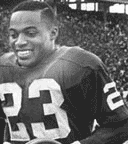 Jerry Levias
|
In his first game of the 1966 season, WR Jerry Levias of Southern
Methodist made history by becoming the first
African-American player for a Southwest Conference team.
The
story began four years earlier when the Dallas school courted
Arkansas
assistant Hayden Fry to be its head coach.
- A native Texan, Hayden wanted the job but only
if SMU agreed
to let him recruit a black player. The school eventually agreed.
- Once ensconsed in the position, Fry discovered that
his task would be harder than he thought. SMU
required a minimum 1,000 score on the SAT while all other conference
schools accepted 750.
- So Fry needed to find
a black player who was an outstanding student. And he needed
to be a terrific athlete. There was no sense recruiting the
first African-American only to have him linger on the bench.
|
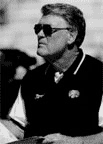 Coach Hayden Fry
|
It took several years, but Fry found his player
in the QB of segregated Hebert High School in Beaumont.
- Jerry Levias was only 5'9" 177 but flashed great speed and elusiveness.
- He had already overcome a major obstacle after suffering a stroke at age 12 that left him unable to walk for five years.
- Furthermore, Jerry wanted to play at an SWC school.
- His mother allowed him to sign with SMU after sensing something "godly" about Fry.
- Hayden needed all his divine powers to convince his team and assistant coaches to accept a black player.
Since freshmen were ineligible in those days, Jerry
had to bide his time and adjust to the same challenges of any
new college student plus the added pressure of being the first
African-American.
- The parents of his first roommate threatened to withdraw their son from school. Peer pressure forced his
second one to move out.
- A teammate spat in his face during practice. Others left the shower room as soon as he entered it after practice.
- Even his old friends in segregated Beaumont, Texas, called him an "Uncle Tom" for attending an all-white school.
- "I really didn't belong anywhere," he said. "The whites didn't want me, and the blacks made fun of me."
- By the spring, he was injured and in danger of flunking out. He almost abandoned his dream.
Levias' first game was a 26-7 victory over Illinois on a rainy evening at the Cotton Bowl.
- He caught a 60y TD pass from QB Mac White on the first play of Q4.
- The Mustangs completed their retaliation for a 42-0 drubbing in Champagne-Urbana
the year before on Jerry's 12y TD reception from backup QB Mike Livingston.
- Levias
led the team in scoring with 54 points as the SMU
won its first Southwest Conference crown in 18 years and the
Cotton Bowl berth that went with it.
- They lost to Georgia
in the New Year's Day Classic, 24-9, to finish 8-3.
- Throughout the season, he had to endure death threats, taunts and late
hits from opponents and the jeers of fans, even at home games.
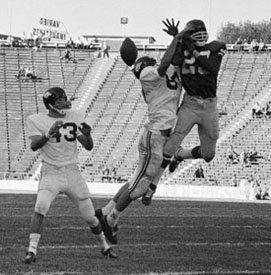 
Jerry Levias in action against Arkansas (L) and Texas A&M.
Nevertheless, in his three years, he set school records that still stand.
- 15 receptions against Ohio State in 1968.
- 1,131y receiving in 1968, the year he finished fifth in the Heisman voting.
- A consensus All-American his senior year, he won the Fort Worth Kiwanis
Club Award for Sportsmanship and was Most Valuable Player in the Senior Bowl.
- He made all-SWC all three seasons.
- In 1969, Levias was NFL Rookie of the Year for the Houston
Oilers.
When
Jerry was inducted into the College
Football Hall of Fame in 2003, the teammate who spit in his face apologized. An opposing player who had done the same thing told Jerry he was raising his children to respect all people.
September 6, 1980: Georgia @ Tennessee
The Vols jumped out to a 15-0 lead as QB Jeff Olszewski ran for one TD and threw a 36-yard pass to WR Mike Miller for the other.
- In Q2, Bulldog coach Vince
Dooley turned to his heralded freshman RB Herschel Walker.
- After Georgia got on the board
with a safety, Walker turned the game around
with a sensational 16y TD run during which he ran over future Cowboys S Bill
Bates at the 10y line, then broke two more tackles
to paydirt. (Watch
a video of the run.)
The score stayed 15-9 until the Junkyard Dog D
recovered Olszewski's fumble at the UT 36.
- This set up the winning drive that was topped off by a 9y
run by – who else? – Herschel Walker.
- The Super Frosh ended the evening with 84y on 24 carries.
Needless
to say, Dooley started Herschel the rest of the season, during which he amassed 1,616 yards and 15 TDs.
- He finished third in the Heisman voting behind George
Rogers, senior RB from South Carolina, and Hugh Green, senior
DE from Pittsburgh.
- After an 11-0 regular season, Georgia defeated Notre Dame 17-10 in the Sugar Bowl to win the AP National Championship.
Walker played two more seasons in Athens.
- He gained 1,891 yards in 1981 and 1,752 in 1982 for a grand total of 5,259.
- Georgia was 33-3 during his three seasons during which they won or shared
the SEC title each year.
- He moved up to second in the Heisman
in 1981 (behind Marcus Allen, USC RB) and then won the award in 1982 over QB John Elway of Stanford and RB Eric Dickerson of SMU.
Herschel played for Donald Trump's New
Jersey Generals in the United States Football League from 1983-5, then in the NFL from 1986-1997.
- In 1989, Dallas traded
him to Minnesota for five players and six draft choices.
- The Cowboys used the windfall to establish the nucleus of their Super Bowl champion teams of 1992, 1993, and 1995.
|

Herschel Walker

Vince Dooley
|
September 16, 1962: Washington Redskins @ Dallas Cowboys
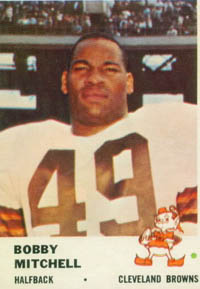

George Preston Marshall
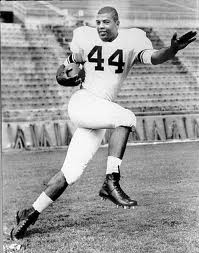
Ernie Davis
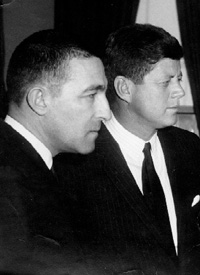
Stewart Udall with President John F. Kennedy
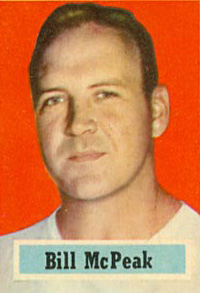
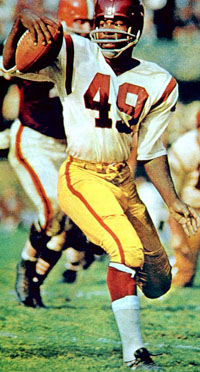
Bobby Mitchell
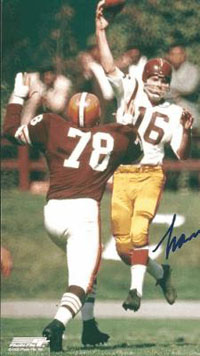
Norm Snead
|
The Washington Redskins obtained Bobby Mitchell in a trade with the Cleveland Browns on December 15, 1961.
- Mitchell had played four years for Paul Brown as a HB and kick returner, providing a smaller, fleet-footed complement to FB Jimmy Brown.
- The Browns received the Redskins' first round draft choice, Syracuse RB Ernie Davis, the first African-American to win the Heisman Trophy.
- RB Leroy Jackson, an African-American like Mitchell, also moved from Cleveland to Washington in the deal.
The trade had unusual significance in the NFL.
- Owner George Preston Marshall's Redskins were the only team in the league that had never signed an African-American player.
- Born in West Virginia in 1896, Marshall had adamantly refused to draft black players, giving as his excuse that the Redskins, as the Southern-most team in the NFL, drew fans from all over the South thanks to their extensive radio network. Marshall claimed that fielding a team of white players, with many from the South, was a business decision and not an indication of racism.
- If virtue is its own reward, then in this case vice was its own punishment. By 1962, the Redskins were the laughingstock of the league. Washington had won only one game each of the previous two years and had not enjoyed a winning record since 1955.
- Ollie Matson of the Chicago Cardinals admitted that he and the other 60 or so black players in the league "try a little harder when we play the Washington team."
Marshall's hand was forced after he signed a contract to play in the new D. C. Stadium (later renamed Robert F. Kennedy Stadium) starting with the 1961 season.
- The change from Griffith Stadium, longtime home of baseball's Washington Senators, coincided with the inauguration of John F. Kennedy as President in 1961.
- Stewart Udall, Kennedy's Secretary of the Interior, informed Marshall that the new stadium, under Udall's authority, could not be used by a professional team that practiced discrimination in its hiring.
- At first, Marshall was defiant and claimed that his 1961 squad was set. However, after young NFL commissioner Pete Rozelle, concerned about the negative publicity Marshall's stance produced, intervened, the Washington owner promised to select a black player in the next NFL draft.
Taking Marshall at his word, Udall granted the Redskins a one-year reprieve on his ultimatum.
- Finishing 1-12-1 in 1961, the Redskins "earned" the first choice in the draft.
- Marshall selected Davis, privately intending to trade him in order to obtain multiple players for his weak team. Preston knew that the brand new American Football League would also draft Davis and that he couldn't afford to outbid the Buffalo Bills.
- When Paul Brown expressed interest in Davis, Marshall effected the trade. Marshall later acquired black G John Nisby from the Pittsburgh Steelers.
Mitchell by no means saw himself as the Jackie Robinson of pro football.
- After attending segregated schools in Hot Springs AK, Bobby played at Illinois before the Browns chose him in the 7th round of the 1958 NFL Draft.
- When he reported to the Redskins training camp at Occidental College in California, Mitchell expressed shock not at the way he was treated but rather at the lack of talent on the field. "This is the team?" he asked Coach Bill McPeak. As Mitchell recalled, "It was a real shock for me becuse I had come from a team with real personnel. It just scared the hell out of me."
- McPeak converted Mitchell to WR to take advantage of his agility and speed.
The new look Redskins began the regular season at the Cotton Bowl against the Cowboys of second-year coach Tom Landry. Mitchell wasted no time in making an impact.
- He scored 3 TDs and set up another.
- He caught a 6y scoring pass from QB Norm Snead to tie the score at 7 in Q1.
- In Q3, after Dallas had pulled out to a 28-14 lead, Bobby returned the kickoff 92y.
- When the Cowboys regained a 14-point lead in Q4, Mitchell hauled in an 81y TD pass from Snead to cut the lead back to 7.
- The Redskins tied the contest on Snead's 1y sneak with 1:56 left. The Snead-Mitchell combo had connected for 26y to spark the scoring drive. Then Dallas was called for interference on Mitchell in the EZ to place the ball at the 1.
- In those pre-overtime days, the game ended 35 all.
The following Sunday, at Mitchell's old stomping grounds, Cleveland Municipal Stadium, Bobby burned his former team.
- With 1:36 left, he caught an 8y button hook from Snead and turned it into a 50y TD to give the two-TD underdog Skins a 17-16 triumph. Bobby explained afterwards, "I caught the ball, skidded over to the sideline, went 'z-z-z-zt' right between two Browns, made a couple of crazy moves, and ran right on over that line."
- The victory was only the fourth for the Redskins in 24 tries against the Browns, who had featured black players since they joined the NFL in 1950 as part of the merger with the All-American Football Conference.
- The man for whom Mitchell had been traded, Ernie Davis, did not suit up for Cleveland because of a "blood disorder" that turned out to be leukemia. In one of the great tragedies in football history, Ernie died May 18, 1963, without ever playing an NFL game.
The Cinderella Redskins won again the following week in their home opener against the St. Louis Cardinals.
- In the opening period, on 4th-and-1, Snead faked a sneak, then drifted back and looped an easy pass to Mitchell, who pulled away from the defenders for a 40y TD.
- Bobby gathered in a 23y scoring pass from Snead in Q2 to push the lead to 14-0 as the Skins won 24-14.
- Washington had already won more games than in either of the previous two seasons.
- The crowd of 39,250 included many fans who had boycotted past games because of Marshall's refusal to integrate the team, including Secretary Udall who attended as the owner's guest.

D. C. Stadium
The Redskins beat the Los Angeles Rams the following week before losing momentum.
- McPeak's club won only two more games to finish 5-7-2, their best record since 1957 but disappointing after the 4-0-2 start.
- Mitchell, though, was everything the fans hoped he would be: 1,384y on 72 receptions with 11 TDs. He was selected for his second Pro Bowl and first of three straight with Washington.
Mitchell played six more seasons in the nation's capital.
- He retired with 7,954 receiving yards, 2,735 rushing, and 3,389 more on kick returns for a total of 14,078.
- Mitchell entered the Pro Football Hall of Fame in 1983.
George Marshall didn't get to enjoy Bobby's exploits very long after the '62 season.
- The owner was diagnosed with arteriosclerosis in 1963 and also suffered from diabetes.
- A few months later, he suffered a mild stroke that hastened his steep mental and physical decline.
- Known all his life as bright, ebullient, and full of ideas, Marshall was a shadow of his former self until his death in 1970.
|
Reference: Showdown: JFK and the Integration of the Washington Redskins, Thomas G. Smith
|
CONTENTS
Johnny Unitas, Louisville
Hopalong
Cassady, OSU
Steve
Young, BYU
Roger
Staubach, Navy
Brett
Favre, Packers
Joe
Namath, Alabama
Jerry
Levias, SMU
Herschel
Walker, Georgia
Bobby Mitchell, Redskins
Dazzling
Debuts - 2
Dazzling Debuts - 3
Football
Page
Golden
Rankings Home
|
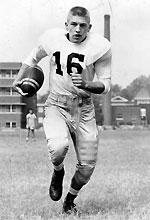 Johnny Unitas at Louisville
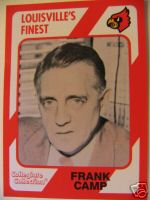
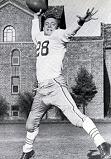
Ted Marchibroda
|




















